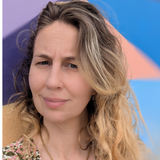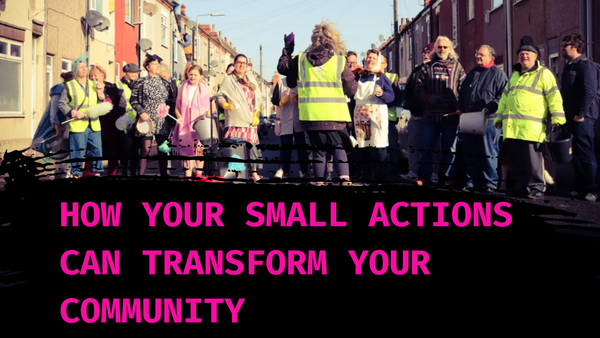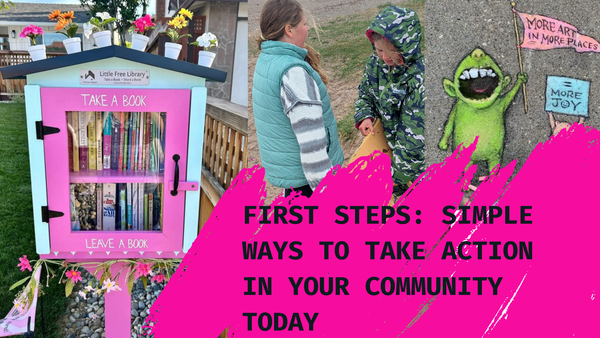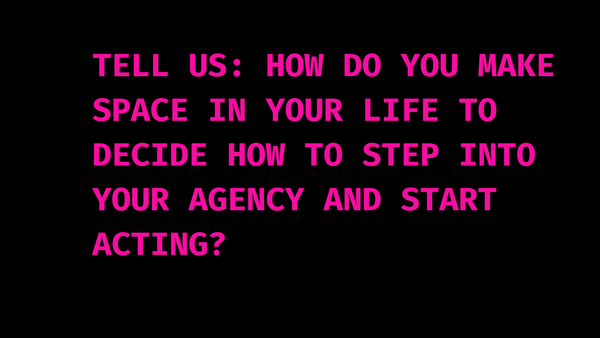How to find your people to start taking action together
ACTionism is the art of finding your people and taking collective action. But how exactly do you find your people? Here's how others did it. We've talked to community members and groups to collate how they did it - so you can find your people!

ACTionism - the art of finding your people and taking collective action - but how exactly do you find your people to start taking action together?
Here are our top tips from communities and groups already flourishing in the art of ACTionism.
Step 1: WAYS TO DISCOVER WHAT OTHERS CARE ABOUT
Listen actively:
- Talk to people - be curious about what frustrates them, but also what lights them up!
- Pay attention to recurring complaints or concerns you hear in conversation
- Ask at community hubs - libraries, cafés, community centres - what are people concerned about
- Look at community Facebook groups and Nextdoor to see what people are discussing and worrying about
Observe and notice:
- Walk around your area - what needs fixing? What are people already doing?
- Check notice boards, social media, and local council agendas for issues people are raising
- Notice informal conversations at the school gates, parks, shops
Start small conversations:
- Have casual chats with neighbours, friends, and people at the school gate
- Ask: "What would make you feel better about where we live?"
- Share your own concern and see who relates to it
Do a simple survey:
- Create a WhatsApp group or email asking: "What's one thing you'd like to see change locally?"
- Post on local Facebook groups asking what's frustrating people
- Use an online form (Google Forms works well) or knock on doors and ask your neighbours what bothers them - this is how Lawrence Weston got started (see below)
CHECK OUT THESE GROUPS OR INDIVIDUALS THAT STARTED WITH ONE SMALL ACTION AND BECAME POWERFUL MOVEMENTS OF COLLECTIVE ACTION

East Marsh United (Grimsby)
In 2017, a neighbour encouraged Billy Dasein to attend their council meeting: "Our mam's would have gone." At the meeting, residents vented frustration about housing, unemployment, and drug abuse - but councillors had no solutions. Billy stood up and offered something different. Using the Broken Windows Theory (visible decay drives further decay), he proposed: "I just said we should get together and clear up, simple as that really. I got a round of applause, so I said to leave me your name if you're up for it."
Fifteen people left their names. That action -consistent litter picks - built momentum and revealed the real issue: housing. Now they've renovated three boarded-up homes as social rental properties, and in 2022, they launched a community share offer to raise £500,000 for ten more homes. They also run arts programmes, a community magazine, and employment initiatives.
Connection point: Council meetings and neighbourhood concerns about visible decay, which became an open invitation to perform a repeated action (weekly litter picks), during which connections flourished and ideas grew.

Ambition Lawrence Weston (Bristol) started in 2012 when residents noticed their community facilities disappearing. To understand what people actually wanted, they trained local residents to knock on every door in the estate with three questions:
What's good about Lawrence Weston?
What's not so good?
What needs changing?
Unlike top-down consultations, these neighbour-to-neighbour consultations led to a tangible five-year Community Development Plan. Next up, the community identified community-owned renewable energy as a solution. In 2023, they commissioned England's largest community-owned onshore wind turbine, which now generates over £100,000 per year to reinvest in fuel poverty support and community projects. They also built a £2.2 million community hub with energy-efficient design, a library, fitness facilities, and mental health support.
Connection point: Community facilities closing sparked listening through door-knocking that helped to identify what people actually needed (warmth, income, community spaces)
Coalville CAN (Leicestershire) was founded during lockdown as a Community Benefit Society (CBS) focused on community wealth. They took over unused office space and employed 68 young people through government schemes. Now they've created a creative hub with repair spaces, craft rooms, and galleries. Most recently secured £250,000 in government funding to own their community building debt-free, permanently keeping the space in community hands.
Connection point: A conversation about community benefit societies - empty buildings - local people wanting change in their town
Party Kit Network was founded in 2019 when Isabel Mack heard about reusable party kits on a podcast. She realised there was momentum—she found 40 existing party kits within 2 weeks. The Party Kit Network was born to connect them. Now, over 500 members globally have prevented more than 1 million single-use items from going to landfill.

No Crap Parties and The Kids Party Pact was founded by Charlotte Mason-Curl, who experienced a rush of climate anxiety after giving birth to her daughter. Charlotte started by hosting a Toy Swap for local parents - a simple event where families could swap their children's outgrown Christmas gifts for free, avoiding waste and new consumption. The feedback was overwhelmingly positive. From these conversations and the realisation that parents were desperately wanting to break free from the gifting status quo (43% said buying presents for parties strained their family finances, and only 9% actually enjoyed it), No Crap Parties was born. The Kids Party Pact followed—a collective pledge in which parents agree not to give plastic-filled party bags, to give secondhand, homemade, or experience gifts instead, and to provide guidance on greener gifting. What started as one mum's anxiety about the future became a movement of thousands.
Connection point: Personal concern (climate anxiety for her daughter's future) and noticing a shared frustration (parents dreading the gifting aspect of parties)
This led to creating a simple test event (Toy Swap) that revealed real appetite for change

Litter per Follower Started by Samuel Salamone as an individual challenge: 100 pieces of litter picked for 100 days, shared on Instagram to inspire followers to do the same. He now has 853K followers and is growing into a social media-driven movement in which other individuals document their own litter-picking, sparking action across the world.
Connection point: One person's personal challenge shared on social media and an invitation for others to join
THE PATTERN ACROSS ALL OF THEM
Notice what's common:
- They all started with one frustration or need (visible decay, wasted parties, littering, empty buildings)
- They began with visible, repeated action (weekly litter picks, starting a kit, documenting picks)
- Connection happened through showing up (consistently being there, speaking about it, sharing it online)
- The movement grew because people could see it working and felt invited to participate
- Early wins (cleaner streets, connected parents, renovated homes) built momentum for bigger action
None of these started with a perfect plan or a mass movement. They started because someone noticed a need, took action, and found their people.






